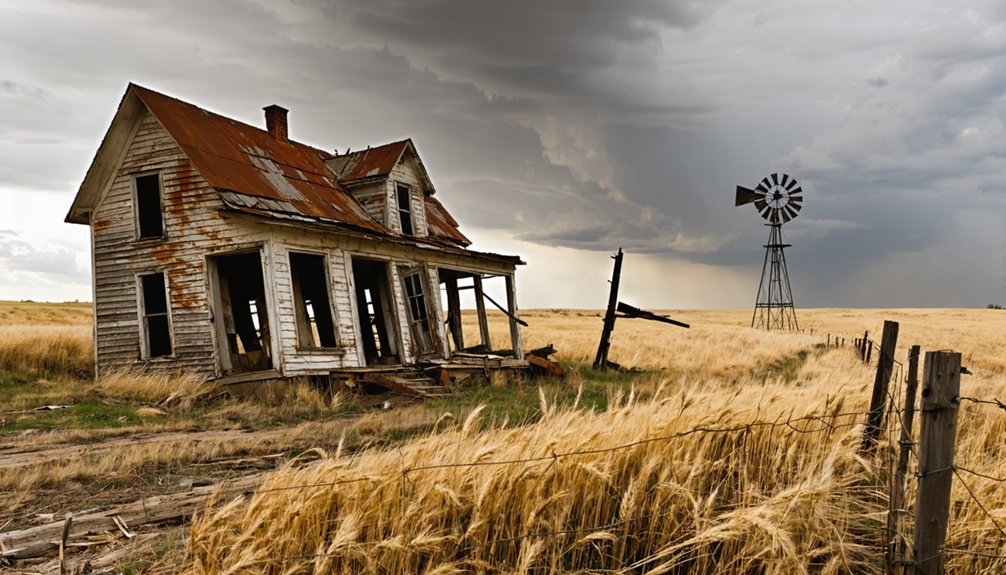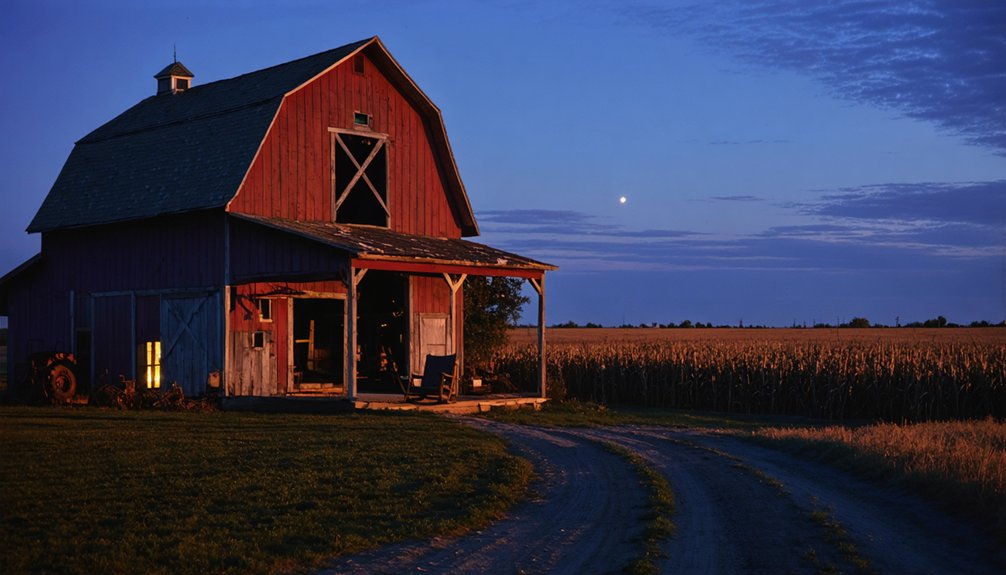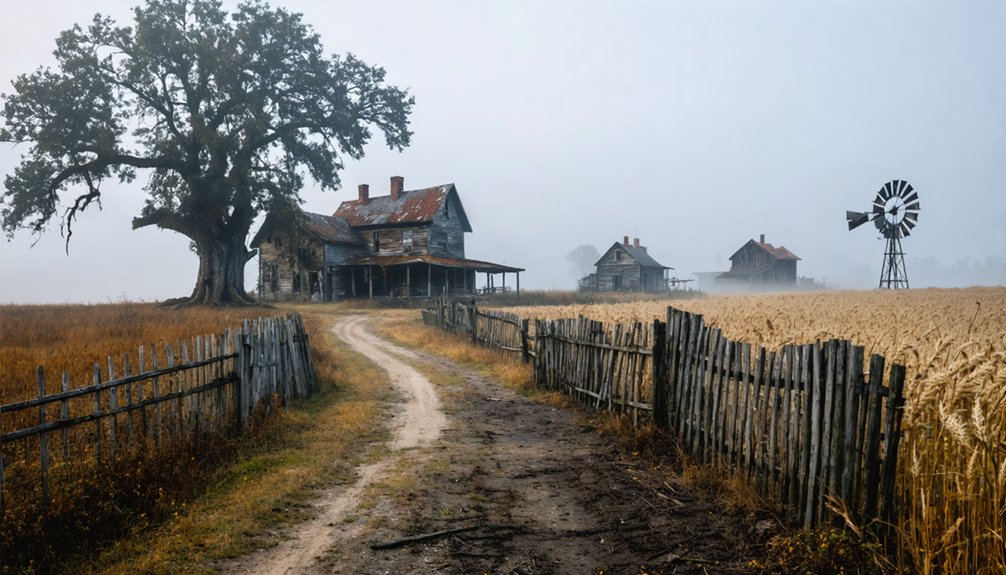America’s abandoned farming communities tell stories of economic hardship and environmental disaster. You’ll find Barnard, Kansas with its deserted Main Street, Oklahoma’s Dust Bowl homesteads, Ruby’s cotton empire ruins in South Carolina, and Turin’s empty Victorian dairy buildings in New York. Nebraska’s Steele City struggles to preserve its agricultural heritage, while vast farmlands in the Mississippi Valley return to nature. The Great Plains’ silent towns reveal America’s forgotten rural history.
Key Takeaways
- Barnard, Kansas, established in 1887, features a deserted Main Street with only surviving grain elevators following the Dust Bowl’s devastation.
- Ruby, South Carolina’s abandoned cotton empire contains weathered gins and collapsed tenant homes after cotton prices plummeted during the Great Depression.
- Turin, New York has Victorian-era remnants of a once-thriving dairy center where two-thirds of small farms vanished within 20 years.
- Steele City, Nebraska maintains historic sandstone buildings despite rural depopulation, with preservation efforts led by the Jefferson County Historical Society.
- The Dust Bowl created numerous ghost towns across Oklahoma and Texas as 2.5 million people fled devastating environmental conditions.
The Forgotten Grain Towns of Kansas: Barnard and Beyond
As you travel through the rolling plains of central Kansas, the small town of Barnard stands as a poignant reminder of America’s shifting agricultural landscape. Established in 1887 and incorporated in 1904, this once-vibrant grain economy has largely faded away, leaving behind limestone buildings that whisper stories of a bygone era.
Barnard’s heritage traces back to cattlemen, Civil War veterans, and Scandinavian immigrants who built their lives around the railroad and fertile farmland. Like the forgotten towns of Finney County, many communities experienced brief periods of prosperity and decline due to environmental challenges. The town thrived until the devastating one-two punch of the Great Depression and Dust Bowl forced many families to abandon their dreams.
Today, you’ll find a mostly deserted Main Street where agricultural technology and farm consolidation have rendered human labor increasingly obsolete. The only businesses that typically survive in such communities are grain elevators, banks, and occasionally a post office. Yet descendants of pioneers remain, tending to larger farms and preserving the legacy of these forgotten grain towns.
Dust Bowl Ghosts: Abandoned Homesteads of Oklahoma and Texas
When the skies darkened and relentless winds scoured the Great Plains in the 1930s, they left behind more than just barren soil—they created a landscape dotted with abandoned homesteads that still haunt the Oklahoma and Texas Panhandles today.
The Dust Bowl’s cruel legacy remains etched in forgotten farmsteads scattered across a once-thriving plain.
You’ll find these Dust Bowl ghosts where 2.5 million people once fled unprecedented environmental impact—homesteads where agricultural collapse meant watching 89 million acres of farmland vanish and 350 million tons of soil blow away.
The economic ruin was staggering: $25 million lost daily by 1936. The catastrophic impact of these dust storms, known as black blizzards, sometimes reached as far as the East Coast, affecting major cities like New York and Washington, D.C.
These empty structures represent massive population displacement, with half a million “Okies” leaving Oklahoma alone. The government response included New Deal programs that attempted to aid these devastated communities but couldn’t prevent their abandonment.
Community decline followed as tax bases evaporated, leaving infrastructure crumbling. Amid soil erosion and health crises from dust pneumonia, entire towns became economically unviable, their freedom and futures carried away like the precious topsoil.
Ruby, South Carolina: When Cotton Was King
In Ruby, South Carolina, you’ll find remnants of a once-thriving cotton empire that transformed small farmers into wealthy planters before the Civil War, with abandoned plantation structures still dotting the landscape.
The Great Depression struck a devastating blow to the already struggling community, as cotton prices plummeted and many farmers lost their lands to foreclosure.
Today, you can explore the ghost town‘s weathered cotton gin, collapsed tenant homes, and overgrown fields—silent witnesses to the boom-and-bust cycle that shaped this forgotten agricultural community. Before the community’s downfall, Ruby was part of the region that produced nearly 20% of America’s cotton by 1860, reflecting its agricultural significance. The economic success of these plantations was built upon the exploitation of slave labor, mirroring the system that generated immense wealth throughout pre-war South Carolina.
Pre-War Cotton Empire
South Carolina’s rise as a cotton powerhouse transformed rural communities like Ruby into vibrant economic centers during the pre-Civil War era. Following Whitney’s cotton gin invention in 1793, upland cotton cultivation spread rapidly across the Piedmont region, creating immense wealth while deepening the state’s tragic dependence on enslaved labor.
As you travel Ruby’s abandoned landscapes today, you’re witnessing the remnants of cotton legacies that once dominated this land:
- By 1820, South Carolina produced 100,000+ bales annually, with communities like Ruby thriving in the profitable upland cotton belt.
- Plantation economies employed over 80% of enslaved workers by 1860, who faced brutal picking quotas of 150-400 pounds daily.
- Local elites built fortunes that shaped the region’s politics and social hierarchies until war brought rural decline.
Unlike the textile industries of New England where factory systems flourished, South Carolina remained predominantly agricultural with most cotton being shipped elsewhere for manufacturing.
Great Depression Devastation
The devastating collapse of Ruby’s once-thriving cotton economy arrived with shocking intensity as the Great Depression tightened its grip on rural South Carolina communities.
You’d scarcely recognize the landscape as cotton prices plummeted from 18 cents to just 6 cents per pound, triggering widespread economic despair.
Boll weevil infestations ravaged fields already weakened by soil depletion from decades of monoculture farming.
Black sharecroppers faced impossible choices—grow food to survive or plant cash crops for landlords—while sinking deeper into debt bondage.
As agricultural decline accelerated, thousands abandoned their homes, seeking survival in textile mills that processed the very cotton they once grew.
Despite limited federal relief efforts, over a million acres were lost to tax sales, forever changing Ruby’s farming heritage.
The social landscape was defined by unpainted shacks scattered across cotton fields, visible symbols of the extreme poverty that characterized tenant living conditions throughout the region.
The Agricultural Adjustment Act of 1933 provided some relief by implementing quota plans that aimed to balance supply with demand, but for many Ruby farmers, this intervention came too late.
Ghost Town Remains
While driving through Ruby today, you’ll encounter haunting reminders of its cotton kingdom glory—abandoned gin mills with rusted machinery, weathered plantation homes with sagging verandas, and overgrown fields where sea island cotton once flourished.
These artifacts tell the story of South Carolina’s cotton legacy, when the state produced nearly 20% of America’s cotton by 1860.
The plantation ruins reveal three distinct chapters:
- The economic boom (1790s-1860s) when cotton transformed Ruby into a thriving community
- The unsustainable agricultural practices that depleted fertile soil, forcing constant expansion
- The eventual collapse following the Civil War, boll weevil infestation, and economic depression
You’re witnessing the remains of a once-mighty agricultural system that employed 80% of the enslaved workforce before its ultimate unsustainability led to abandonment. Like the declining textile industry that once created thriving villages along the Deep River, operations eventually shifted overseas, leaving behind only architectural ghosts of former prosperity.
Turin, New York: A Dairy Empire’s Empty Streets
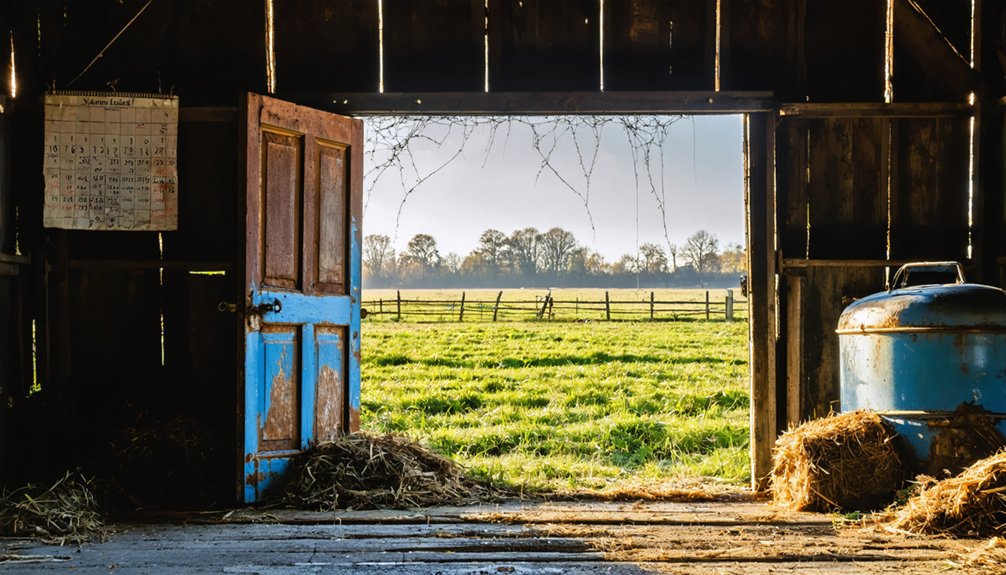
If you’d traveled to Turin, New York, in the late 1800s, you’d have witnessed a thriving dairy empire with bustling streets lined with Victorian-era buildings that now stand empty and silent.
The once-proud dairy operations that sustained generations of families have dwindled dramatically, leaving behind crumbling barns and vacant storefronts as evidence to rural America’s changing landscape.
Nestled in the forgotten reaches of Tug Hill, Turin exemplifies how agricultural communities can vanish when their economic foundations erode, despite the rich history preserved in structures like the Dewey House.
Dairy’s Slow Downfall
Once a thriving center of dairy production, Turin, New York now stands as a sobering reflection of the dramatic decline of small dairy farms throughout the state.
You’ll find empty streets where dairy farmers once brought economic significance to this rural community. The pattern of dairy consolidation has transformed the landscape, forcing smaller operations to vanish while larger farms expand.
The dairy decline’s stark reality is evident in:
- Two-thirds of New York’s small dairy farms have disappeared in just 20 years
- Farm numbers plummeted from 9,300 in 1997 to only 3,000 by 2022
- Production costs increased by nearly 50% since 2017, making survival impossible for many
This rural depopulation carries serious consequences for communities like Turin, where closed family farms have disrupted generations of agricultural tradition and community bonds.
Victorian Ghosts Remain
Walking through Turin today, you’ll encounter the haunting remnants of a once-thriving Victorian dairy empire. The ghostly shells of factories and Victorian-era homes stand as abandoned relics along empty streets, telling stories of agricultural prosperity that vanished decades ago.
The Giles Foster house from 1799 remains remarkably preserved, while a documented 1850s farmhouse—owned by the same family until the 1990s—now sits boarded up, slowly returning to the earth after more than 20 years of abandonment.
Where the cannery once employed 150 workers processing local produce, you’ll find repurposed spaces or nothing at all.
Some crumbling farmhouses have found new purpose as informal artist havens, where creators salvage materials from these historic structures, preserving fragments of Turin’s agricultural heritage in unexpected ways.
Tug Hill’s Forgotten Town
Turin, New York stands as a poignant example of America’s vanishing agricultural communities. Walking its quiet streets today, you’ll discover forgotten architecture where a thriving dairy empire once employed hundreds.
The 1885 Turin Canning and Pickling Company, now vanished, processed harvests from surrounding farms that fed America’s growing population.
This agricultural nostalgia manifests in:
- Abandoned mills where farmers once ground their grain
- Empty factory locations now repurposed as children’s playgrounds
- Historic homes like the 1799 Foster house preserving early settlement heritage
You’re witnessing the aftermath of economic shifts that forced residents to seek opportunity elsewhere.
As transportation routes changed and agricultural economics evolved, Turin’s vibrant community center gradually emptied, leaving these silent monuments to America’s farming heritage.
Nebraska’s Silent Plains: Steele City’s Preservation Struggle
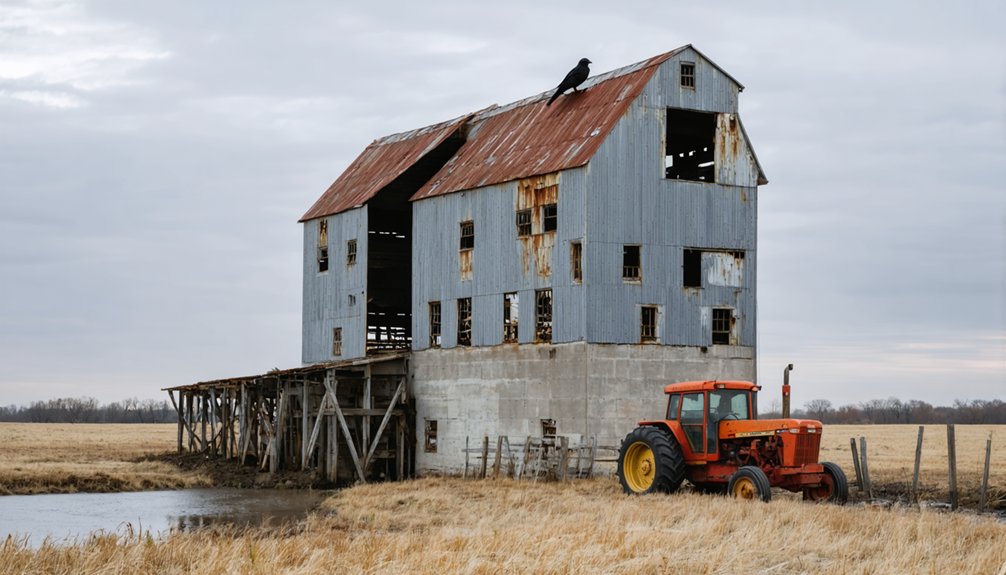
Deep in the heart of Nebraska’s sweeping plains sits Steele City, a symbol of America’s agricultural past that now fights a quiet battle for preservation. Founded in 1873 and named after a railway president, this once-thriving hub faces severe rural depopulation and economic stagnation.
You’ll find historic architecture in remarkable condition—sandstone and brick buildings including a bank, blacksmith shop, and 1880s stone church—standing defiantly against time. Since the 1980s, community initiatives have breathed new life into these structures.
The Jefferson County Historical Society has spearheaded restoration efforts, particularly of the historic bank that now offers glimpses into turn-of-the-century life.
While many original buildings remain vacant, preservation challenges haven’t deterred locals from maintaining this authentic piece of railroad and agricultural heritage.
Mississippi River Valley: Farmlands Reclaimed by Nature
Throughout the fertile floodplains of the Lower Mississippi River Valley, nature steadily reclaims what was once America’s agricultural heartland. Since the 1980s, over 30 million acres of cropland have been abandoned, with a significant portion in the Mississippi Alluvial Plain.
These abandoned ecosystems are transforming as you witness rural regeneration happening in real time.
The transformation follows predictable patterns:
- About 50% converts to grassland and pasture
- Roughly 19% returns to native shrubland and forest
- Approximately 8% reverts to essential wetlands
Surprisingly, less than 20% of these lands participate in federal conservation programs.
The natural rewilding process supports biodiversity, improves water retention, and enhances flood control—restoring ecological functions along the river corridor that were disrupted by decades of intensive farming.
Great Plains Exodus: The Quiet Crisis of Rural Flight

While the Mississippi Valley witnesses natural reclamation of former farmlands, another profound transformation unfolds across America’s heartland.
Drive through the Great Plains today, and you’ll encounter a sobering reality of rural decline – communities where 60-80% of the population has vanished.
The landscape tells the story: shuttered Main Streets, abandoned schoolhouses, and consolidated megafarms replacing family operations.
Since 1980, a staggering 86% of rural counties have lost residents. Population migration follows economic necessity, as farm consolidation and mechanization eliminate traditional livelihoods.
You’ll find isolated pockets where international immigration partially offsets the exodus, particularly in Nebraska.
But for many communities, population densities have fallen below two people per square mile – creating vast, quiet expanses where vibrant communities once thrived.
Frequently Asked Questions
Can Abandoned Farm Communities Be Legally Homesteaded Today?
You can’t legally homestead abandoned farms under original homesteading laws today. These properties have existing property rights, requiring purchase or adverse possession through established legal channels.
How Do Property Taxes Work in These Abandoned Farming Towns?
You’ll face property assessment based on potential use, not actual condition. Tax exemptions may exist for historical preservation, but you’re still liable even if the town’s abandoned.
Are There Intact Artifacts Worth Collecting From These Communities?
While staggeringly rich in collectible history, you shouldn’t remove artifacts without permits. Artifact preservation requires proper documentation and landowner permission. Freedom to explore doesn’t mean freedom to take these irreplaceable treasures home.
What Safety Hazards Exist When Exploring Abandoned Farm Structures?
You’ll face serious dangers including structural instability from rotting timbers, toxic chemical exposure, confined space entrapment, mechanical hazards from abandoned equipment, and wildlife encounters including venomous snakes and rabid animals.
Do Former Residents Hold Reunions or Maintain Connections to These Places?
Over 75% of former residents maintain connections through nostalgic gatherings and social media groups. You’ll find these community memories preserved through annual reunions, shared photo archives, and collaborative oral history projects.
References
- https://www.technologynetworks.com/applied-sciences/news/new-us-map-shows-the-abandoned-farms-that-could-help-fight-climate-change-387249
- https://pmc.ncbi.nlm.nih.gov/articles/PMC9735913/
- https://ci.uky.edu/irj/rural-blog/new-tool-finds-abandoned-farmland-could-be-used-fight-climate-change-30-million
- https://www.towson.edu/fcsm/departments/environsci/undergrad/documents/small-farms-2005.pdf
- https://blogs.loc.gov/maps/2023/12/climate-migrants-of-the-1930s-dust-bowl/
- https://en.wikipedia.org/wiki/Rural_American_history
- https://www.theamericanconservative.com/photographing-the-ruins-of-rural-america/
- https://www.legendsofamerica.com/gt-emergingghosttowns/
- https://www.youtube.com/watch?v=Rk9zFu-ATo4
- https://www.k-state.edu/history/about/news/lostbutnotforgotten.html
